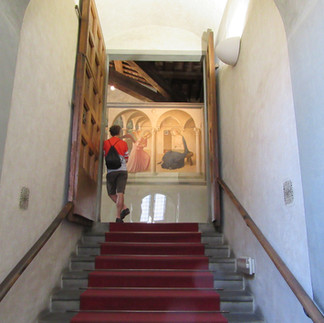Fra Angelico and Fra Filippo Lippi: One was Pious, One went Rogue
- Gerriann Brower
- Oct 28
- 8 min read
Two friars became renowned early Renaissance Florentine painters. Fra Angelico was a pious friar whose faith was mirrored in his art and was later beatified. Fra Filippo Lippi, the rogue friar, fathered two children with a nun. Each was celebrated for their innovation and style.

Born Guido di Pietro, Fra Angelico (1390s-1455) worked as a Dominican artist in Fiesole then Florence. “Fra” means “brother,” short for Fratello in a religious order. A prolific painter, his most famous frescoes are located in Florence’s Dominican Convent of San Marco. Angelico and his studio frescoed forty-four of the cells, dormitory, and chapter house of the friars. Other artists also contributed frescoes to the convent. The Dominican religious order was influential in Florence as art patrons and for their teachings on morality. Two famous citizens had cells in the complex: one for its patron Cosimo de' Medici and one for the stern and uncompromising preacher Girolamo Savonarola (later deemed a heretic and burned at the stake).
Early fifteen century Florence was a prosperous large urban city. The cloth industry and banking were its economic engines. Major artworks completed or in progress at the time include Fra Angelico’s frescoes at San Marco, Masaccio’s ground breaking fresco of the Trinity in Santa Maria Novella and Filippo Brunelleschi’s Dome on the Cathedral Santa Maria del Fiore. The San Marco Convent is a perfect example of fifteenth century Florentine religious and cultural norms, a snapshot of life under the ruling leader Cosimo de’ Medici.
Fra Angelico was a transitional artist during the first half of the 1400s. He bridged different styles, introducing natural light, figurative realism, compositional harmony, and recognizable Tuscan landscapes in the background. He often remained true to tradition using decorative and ornamental touches. Fra Angelico had clients from religious as well as lay organizations, prominent families, and ran an established studio. His art exerted great influence for decades to come.
His Annunciation, in the quaint Tuscan town of San Giovanni Valdarno, adheres to conventional Gothic gold decoration in the architectural elements, drapery, and halos. The Annunciation depicts the angel Gabriel announcing to Mary that she will be with child via the Holy Spirit who is positioned above Mary’s head. Her garden, a symbol of her purity, is visible through the arches in the background. Mary humbly folds her arms in an act of surprise. Angelico painted his altarpieces with intense hues, using gold details in fabrics, and rendering textiles with softness and clarity.
Fra Angelico, Annunciation, 1432-35, Museo della Basilica di Santa Maria delle Grazie, San Giovanni Valdarno, Tuscany. Photo Gerriann Brower.
Fra Angelico’s paintings – particularly wood panel paintings – exude a luminous quality, a mystical serenity using stunning colors. The pink unifies the composition in the clothing, the painted band around the interior space, and the blotches of pink used to signify marble. There is considerable rose coloring in the predella panels (the smaller panels below the main picture). He uses gold to signify the divine. His figures are always calm, graceful, and refined. He uses gold sparsely in his later paintings.
In contrast, the frescoes for the convent are sparse, pared down compositions meant to invoke contemplation and prayer. The tempera medium on wood panel requires layers of small brushstrokes, which are perfect for detail and evoking textured surfaces. Tempera was a labor-intensive method whereas fresco required quick work, applying pigments on wet plaster, covering only a small section a day. Fresco does not allow for layering colors or luminosity. Fresco resembles the method of watercolor and tempera that of oil painting.
Angelico’s Annunciation for the San Marco convent is situated at the top of the stairs leading to the friar’s cells. It stops visitors in their tracks with its simplicity, as it was intended to for the monks walking up the stairs to their cells. His traditional composition uses architecture to separate and organize the scene. Mary modestly folds her hands and wears a simple blue garment. The magnificent rainbow-colored angel’s wings evoke the mystical nature of the event. Known in his day as the “angelic painter,” his fresco evokes holiness with its clarity and color.
Fra Angelico, Annunciation, 1438-45, Museo di San Marco, Florence. Photo Gerriann Brower.
Sixteenth century biographer Giorgio Vasari called him a simple and holy man who could have been rich and powerful but chose humbleness and cared little for earthly things. When painting a Jesus on the cross he did so with tears streaming down his face. He moved to Rome to serve the pope and died mid-century at the age of fifty-five. Angelico's devotion to his faith was mirrored in his paintings. He is buried in the Roman church of Santa Maria sopra Minerva. He was beatified in 1982 by Pope John Paul II.
Filippo Lippi, born about ten years after Angelico, entered the Carmelite order at a young age as an orphan after relatives were too poor to take care of him. Unlike his friar counterpart, a religious order was a poor vocation for him, although he did not have a choice in the matter. Filippo showed a talent for drawing, and lacked interest in arithmetic or grammar, so the prior of the order set him up to learn painting. At fifteen he took vows in the religious order but later left the monastery. Filippo was a non-conformist who bucked tradition. A bit of a rogue. Owing to his talent and patrons, he created a life of his choosing. He navigated two worlds, one as a monastic and one as a secular painter.
Part of what we know about Filippo is legend, and some of it documented. Leaning towards legend is his dramatic kidnapping. Working as an artist in Ancona on the Adriatic Sea, he went with friends in a boat off the coast. The vessel was captured by Moorish pirates. Held captive for months and enslaved in the North Africa Barbary Coast, he earned his freedom after he took a burnt coal from the brazier and drew his captor on a white wall. Impressed, his captor had him released in Naples. He returned to his native Florence where Cosimo de’ Medici became his patron.
Records show Filippo was nothing like Angelico. Often habitually late in finishing contracts, or sometimes abandoning work, Filippo pursued his favorite pastime: women. His lustful nature interfered with his work. Cosimo de' Medici once locked him up for two days so he would continue painting a commission. He escaped by tying bedsheets together, lowering himself out a window, and pursuing his greatest pleasure. His choices often landed him in legal difficulty when behind in paying assistants or fulfilling contracts, along with his sexual appetite as a Carmelite monk. Between 1450-1463 he was involved in twelve legal disputes, as defendant and accuser. Once he was accused, tried, and tortured on the rack for his misdeeds.

His reputation did not hinder commissions from churches, rich clients, and convents. His double portrait is a departure from his religious artworks and is the earliest extant double portrait in Italy. Set in a home, this is most likely a marriage portrait. He paints the couple in profile, a traditional pose for portraits at the time. She wears a highly fashionable scarlet gown and headdress, pearls, and rings. Her spouse peaks in through the window, in an intimate moment. His hands rest on a coat of arms (most likely) of his family. Both are nobility. Her lightened hair and high forehead, achieved by plucking or shaving the hairline, was in keeping with Renaissance style. A highly ornamented pearl encrusted beaded head covering denotes the bride’s social standing.
Filippo paints with a naturalistic treatment of the figures. A light source comes from the left as the man’s face casts a shadow on the casement. A glimpse of a landscape complements the setting. Filippo presents a fresh take on portraiture with his interest in light and shade, depicting the natural world, and innovation using windows to frame the couple.
A life-changing commission was an altarpiece for the nuns of Santa Margherita in Prato, outside of Florence. He became smitten with a nun, Lucrezia Buti, and painted her as the Madonna. A scandal ensued. A denunciation to the Office of the Monasteries and the Night (morality enforcement) revealed that by mid-century not only Lucrezia and Filippo were living together in a house – not the monastery - but also with her sister and five other nuns. Filippo had seven women under his roof! During the same period Lucrezia gave birth to a son, Filippino, and later, a daughter. There is some question as to whether Lucrezia was equally enamored and whether her pregnancy was the result of a consensual relationship. Lucrezia returned to the convent only to leave again and return to Filippo.
Filippo was one of the preeminent painters in Florence, especially after Angelico left for Rome. Cosimo de’ Medici intervened with the Pope to release Filippo and Lucrezia from their vows. The Medici were influential papal bankers and Pope Pius II gave his dispensation. The couple were allowed to marry, although Vasari claims Filippo refused to marry in order to pursue his amorous affairs. “He lived honorably from his labors and spent exceptional amounts on his love affairs, which he continued to enjoy throughout his life up to the time of his death.”* His affairs may have done him in. Vasari erroneously reports relatives of the Buti family poisoned him while he was working in Spoleto. He died in 1469 at age sixty-three, most likely of heart disease.
Fra Filippo Lippi, Annunciation, 1445-50, Galleria Doria Pamphilj, Rome. Photo Gerriann Brower.
Filippo had a knack for depicting feminine beauty and grace, evident in his Annunciation. He departs from tradition with the angel approaching from the right, not the left. Mary is depicted in her usual demure pose. He does away with painted arches to separate the scene and includes as many Christological and Marian symbols as possible. The lilies in the angel’s hand and vase refer to her purity. The Holy Spirit is sent down with the assistance of God’s hands, as she accepts God’s will. A view to a garden denotes the Garden of Eden and reminds viewers of her virtue. The brilliant colors and clear contouring of the figures and architectural elements are signature Filippo Lippi. The alignment of the marble floor, walls, and furniture shows his interest in geometry and perspective.
Although Filippo died in 1469, his legacy was long. Sandro Botticelli was his able student. His son Filippino became an esteemed artist who trained under Botticelli. After leaving Botticelli’s studio, he gained fame as an independent painter in Florence and Tuscany. Angelico, the Lippi men, and Botticelli were part of a Florentine golden age under the Medici. Filippino lived long enough to see Michelangelo’s David completed, heralding the end of an era and the beginning of another.
*Vasari, p. 198.
Sources
Ahl, Diane Cole. Fra Angelico. Phaidon Press, 2008.
Goldfarb, Russell M. “Fra Lippo Lippi’s Confession.” Studies in Browning and His Circle, vol. 13, 1985, pp. 59–69.
Holmes, Megan. Fra Filippo Lippi: The Carmelite Painter. Yale University Press, 1999.
Nelson, Jonathan K. Filippino Lippi: An Abundance of Invention. Reaktion Book, 2022.
Strehlke, Carl Brandon. Fra Angelico and the Rise of the Florentine Renaissance. Thames & Hudson, Museo Nacional del Prado, 2019.
Vasari, Giorgio. The Lives of the Artists. Translated by Julia Conaway Bondanella and Peter Bondanella. Oxford University Press, 1991.















